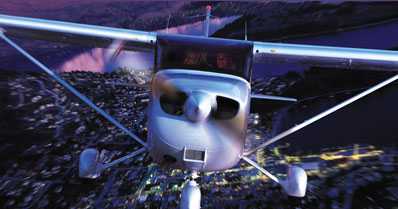Sturdy, Stalwart Plane Has Been Flown By A LOT Of
Pilots
Say what you will about the somewhat dowdy Cessna 172 -- it's
likely you'll do so with respect, even if at first your comments
may not seem complimentary. After all, the 172 has never been the
sexiest aircraft on any ramp... anywhere.

With its strut-mounted high-wing, pug nose, and
compact dimensions, it takes a practiced eye to identify a
brand-new leather-and-G1000-equipped SP from a well-kept shag,
steam-gauge, and Royalite-bedecked model from 30 years ago. The new
model will also go about as fast, with 120 knots indicated on a
good day -- hardly Cirrus numbers.
And for a multitude of pilots, that's more than fine. Known for
its docile flight characteristics, the Skyhawk (as the model became
known by in the late 60s) has endeared itself to three generations
of pilots over its 50 years of existence. Much has changed about
the actual aircraft -- but the spirit remains the same, and the EAA
will honor that spirit at AirVenture 2006 in Oshkosh by saluting
the 50th anniversary of the general aviation mainstay.
 Since its introduction in 1956, the
Cessna 172 has become the most successful small airplane in
history. Countless pilots have learned the basics of flight
in its cockpit and many of them continue to fly the familiar
high-wing aircraft throughout North America and from locations
around the world.
Since its introduction in 1956, the
Cessna 172 has become the most successful small airplane in
history. Countless pilots have learned the basics of flight
in its cockpit and many of them continue to fly the familiar
high-wing aircraft throughout North America and from locations
around the world.
"The Cessna 172 may not be the fastest or flashiest airplane on
the flight line, but perhaps more than any other airplane, it has
allowed people to realize their dreams of flight," said Tom
Poberezny EAA president and AirVenture chairman. "The Cessna
172 brings thousands of aviation enthusiasts to Oshkosh each year
to what's known as 'aviation's family reunion,' and this year we
invite anyone who owns or has flown this workhorse aircraft to come
to Oshkosh to celebrate its golden anniversary."
Among the invited aircraft for this commemoration is the very
first Cessna 172, a 1956 model still flown regularly by EAA member
Joe Nelsen of Grayson, TX. EAA is also working with Cessna
Aircraft, the Cessna Pilots Association and other Cessna owner and
pilot groups to recognize the aircraft and their owners during the
event.
Other Cessna 172 activities during EAA AirVenture include:
- Cessna 172s arriving and parking together in AirVenture's
"North 40" aircraft camping area;
- A display of notable Cessna 172s on AirVenture's showcase
AeroShell Square, including the first and most recent models;
- A schedule of AirVenture forum speakers and topics specifically
on the Cessna 172;
- A special exhibit of the artwork of Richard Van Eyck, Cessna's
consulting design engineer from the 1950s through the 1980s, which
encompasses original sketches and designs for paint schemes,
interiors and other items for many Cessna aircraft, including those
never produced;
- An evening event at the EAA AirVenture Museum celebrating the
172's 50th anniversary.
The Cessna 172 began as a tricycle-gear version of the
tailwheel-equipped Cessna 170, which had a basic level of standard
equipment. The new 172 model proved to be an instant success, with
more than 1,400 built in 1956, the first full year of
production.
Since the airplane's introduction, more than 42,500 Cessna 172s
have been built, making it the most successful mass-produced
aircraft in history. They have become the most recognized
single-engine civilian aircraft in the world, used around the globe
for flight training, business, recreation and humanitarian
efforts.
The Cessna 172 has also flown more than 20 percent of the 1.2
million Young Eagles flown by EAA-member volunteer pilots since
that program began in 1992.
"Although EAA members and AirVenture attendees fly or enjoy just
about every aircraft known to man, it's not a stretch to say that
the largest number of them either learned to fly or have flown a
Cessna 172," Poberezny said. "It's an airplane that has allowed
many people to get started on the path to their own dreams of
flight and their individual aviation achievements."
 Classic Aero-TV: Active Winglets -- Tamarack Aerospace Partners with Cessna
Classic Aero-TV: Active Winglets -- Tamarack Aerospace Partners with Cessna Aero-News: Quote of the Day (05.03.25)
Aero-News: Quote of the Day (05.03.25) ANN's Daily Aero-Term (05.03.25): Taxi
ANN's Daily Aero-Term (05.03.25): Taxi ANN's Daily Aero-Linx (05.03.25)
ANN's Daily Aero-Linx (05.03.25) Airborne 05.02.25: Joby Crewed Milestone, Diamond Club, Canadian Pilot Insurance
Airborne 05.02.25: Joby Crewed Milestone, Diamond Club, Canadian Pilot Insurance




